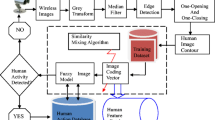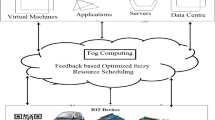Abstract
The Internet of Things is a new round of information technology revolution after computers, the Internet and mobile communications. Internet of Things technology is an important means to improve the level of social information, which will have a profound impact on economic development and social life. IoT can stimulate the economy, increase employment, improve efficiency and make people’s lives and work more convenient. Since fuzzy control can make good use of expert fuzzy information and effectively deal with the complex process of modeling, fuzzy control has received extensive attention once it has been proposed. Fuzzy logic system has become a research hotspot in academic and application fields due to its wide application. Fuzzy system identification includes structure identification and parameter identification. Fuzzy cognitive graph is a kind of soft computing method. It has stronger semantics than neural network because of its intuitive expression ability and powerful reasoning ability. Due to the widespread popularity of visual data acquisition devices, people can use the device to capture a large number of videos and images and spread them over the network in daily learning, production, life, work and entertainment. Computer science and technology, information computing technology, automated detection technology and Internet of Things technology contribute to the research of visual information data. In this paper, we conduct research on the novel QoS optimization paradigm for the IoT systems based on fuzzy logic and visual information mining integration. The experimental results show that the proposed optimization scheme has higher robustness.













Similar content being viewed by others
References
Gates B, Myhrvold N, Rinearson P (1995) The road ahead, 1st edn. Viking Penguin, New York, pp 5–16
ITU Strategy Policy Unit (SPU) (2005) ITU International Reports 2005: the Internet of Things. International Telecommunication Union (ITU), Geneva, pp 8–20
Antoine de Saint-Exupery (2009) Internet of Things-Strategic Research Roadmap, pp 56–77
Mendel JM, John RI (2002) Type-2 fuzzy sets made simple. IEEE Trans Fuzzy Syst 10(2):117–127
Zeng J, Liu ZQ (2006) Type-2 fuzzy hidden Markov models and their application to speech recognition. IEEE Trans Fuzzy Syst 14(3):454–467
Li HX, Tong SC (2003) A hybrid adaptive fuzzy control for a class of nonlinear MIMO systems. IEEE Trans Fuzzy Syst 11(1):24–34
Chen B, Liu XP, Tong SC (2007) Adaptive fuzzy output tracking control of MIMO nonlinear uncertain systems. IEEE Trans Fuzzy Syst 15(2):287–300
Tong SC, Li YM (2013) Adaptive fuzzy output feedback control of MIMO nonlinear systems with unknown dead-zone inputs. IEEE Trans Fuzzy Syst 21(1):134–146
Kamalapurkar R, Walters P, Dixon WE (2016) Model-based reinforcement learning for approximate optimal regulation. Automatica 64:94–104
Feng B, Chen W, Sun J (2006) Chaotic time series forecasting with PSO-trained RBF neural network. In: DCABES 2006 proceedings, vol 2, pp 787–790 (ISTP)
Alpaydin E (2014) Introduction to machine learning. MIT Press, Cambridge
Zhang C, Ma Y (2012) Ensemble machine learning. Springer, New York
Liu Y, Chen J, Su Z et al (2016) Robust head pose estimation using Dirichlet-tree distribution enhanced random forests. Neurocomputing 173:42–53
Louppe G (2014) Understanding random forests: from theory to practice. arXiv preprint arXiv:1407.7502
Friedman J, Hastie T, Tibshirani R (2000) Additive logistic regression: a statistical view of boosting (with discussion and a rejoinder by the authors). Ann Stat 28(2):337–407
Zhang J, Hsu W, Lee M (2001) Image mining: issues, frameworks and techniques. In: Proceedings of the second international workshop on multimedia data mining
Kitamoto A (2002) Spatio-temporal data mining for typhoon image collection. J Intell Inf Syst 19(1):25–41
Guadagnina R, Santanab L, Fernedaa E, Pradoa H (2010) Improving image mining through geoprocessing. J Intell Inf Syst 20(1):81–85
Rajendran P, Madheswaran M (2010) Hybrid medical image classification using association rule mining with decision tree algorithm. J Comput 2(1):127–136
Premchaiswadi W, Tungkatsathan A (2010) On-line content-based image retrieval system using joint querying and relevance feedback scheme. WSEAS Trans Comput 9(5):465–474
Louis J, Dunston PS (2018) Integrating IoT into operational workflows for real-time and automated decision-making in repetitive construction operations. Autom Constr 94:317–327
Thota C, Sundarasekar R, Manogaran G, Varatharajan R, Priyan MK (2018) Centralized fog computing security platform for IoT and cloud in healthcare system. In: Krishna Prasad AV (ed) Exploring the convergence of big data and the internet of things. IGI Global, Hershey, pp 141–154
Pattar S, Buyya R, Venugopal KR, Iyengar SS, Patnaik LM (2018) Searching for the IoT resources: fundamentals, requirements, comprehensive review and future directions. IEEE Commun Surv Tutor 20:2101–2132
Guck JW, Van Bemten A, Reisslein M, Kellerer W (2018) Unicast QoS routing algorithms for SDN: a comprehensive survey and performance evaluation. IEEE Commun Surv Tutor 20(1):388–415
Patel A, Kaushik P (2018) Improving QoS of VANET using adaptive CCA range and transmission range both for intelligent transportation system. Wirel Pers Commun 100(3):1063–1098
Aljawarneh SA, Yassein MB, Talafha WA (2018) A multithreaded programming approach for multimedia big data: encryption system. Multimed Tools Appl 77(9):10997–11016. https://doi.org/10.1007/s11042-017-4873-9
Radhakrishna V, Aljawarneh SA, Kumar PV, Choo K-KR (2018) A novel fuzzy Gaussian-based dissimilarity measure for discovering similarity temporal association patterns. Soft Comput 22(6):1903–1919. https://doi.org/10.1007/s00500-016-2445-y
Aljawarneh SA, Vangipuram R, Puligadda VK, Vinjamuri J (2017) G-SPAMINE. Future Gener Comput Syst 74(C):430–443. https://doi.org/10.1016/j.future.2017.01.013
Aljawarneh SA, Elkobaisi MR, Maatuk AM (2017) A new agent approach for recognizing research trends in wearable systems. Comput Electron Eng 61(C):275–286. https://doi.org/10.1016/j.compeleceng.2016.12.003
Acknowledgements
This study was funded by National Natural Science Foundation of China, No. 61402544.
Author information
Authors and Affiliations
Corresponding author
Ethics declarations
Conflict of interest
The authors declare that they have no conflict of interest.
Additional information
Publisher's Note
Springer Nature remains neutral with regard to jurisdictional claims in published maps and institutional affiliations.
Rights and permissions
About this article
Cite this article
Jiang, X., Ding, H., Shi, H. et al. Novel QoS optimization paradigm for IoT systems with fuzzy logic and visual information mining integration. Neural Comput & Applic 32, 16427–16443 (2020). https://doi.org/10.1007/s00521-019-04020-3
Received:
Accepted:
Published:
Issue Date:
DOI: https://doi.org/10.1007/s00521-019-04020-3




